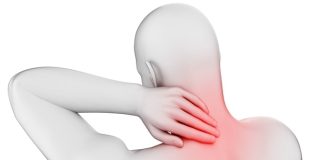If you notice the development of a hump at the base or in the neck, you may be focusing on how strange it looks and thinking that this is due to poor posture. This hump in the neck is sometimes referred to as the “widow’s hump” or “humped back” and is medically known as thoracic kyphosis.
“This bump typically affects the area of the spine called the upper thoracic spine,” says Dr. James E. Dowdell III, MD, spinal surgeon at the Hospital for Special Surgery. “When you have this condition, your head appears to be protruding because your upper thoracic spine has an excessive curvature.”
If you have a bump in your neck you may experience symptoms such as back pain or stiffness, fatigue, tight hamstrings, and rounded shoulders. And although Dr. Dowdell finds that everyone has a natural curve in their spine, there are certain reasons and causes that you can make that curve worse.
What Causes Thoracic Kyphosis?
While several factors can play a role in the formation of the hump, one thing stands out from the others. “The most common cause of the hump is poor posture,” says Dr. Dowdell. “Unfortunately, this becomes a chicken-and-egg scenario as poor posture puts more pressure on the spine, which can worsen the curvature, further exacerbating the existing poor posture.”
Related: Try These 12 Exercises For Bad Posture
Other causes are:
- Osteoporosis (bone disease): “This can change the shape of bones (wedging of vertebrae) if they are not strong enough,” says Dr. Dowdell. “This wedging of the vertebra creates kyphosis in the thoracic spine.”
- Arthritis: “Arthritis in the lower neck area can cause the head to automatically lean more forward to keep the arthritic areas in a more comfortable position,” says Dr. Rahul Shah, MD, a specialist in orthopedic spine and neck surgery with Premier Orthopedic Spine Associates in Vineland, New Jersey. This leaning forward creates a cascade of changes that make the hump more noticeable.
- Scheuermann’s kyphosis: While the normal curvature of the spine is between 20 and 40 degrees, a congenital problem called Scheurmann’s kyphosis creates a curvature between 45 and 75 degrees, according to the University of Maryland Medical Center.
- Muscle weakness: When the muscles in the upper thoracic spine aren’t strong enough, it puts extra pressure on the spine, which can contribute to the development of that curvature, which Dr. Dowdell is now more common due to office work / computers / smartphones.
- Aging: As you age, you may lose significantly more mass in the vertebrae of the spine (either in the neck or in the chest bones), which can lead to postural changes that can accentuate the hump, says Dr. Shah.
- Additional tissue storage through additional fat storage: This can be caused by certain drugs, steroids, conditions like Cushing’s syndrome, and obesity, notes Dr. Shah.
Related: How to Correct Front Head Posture, or “Nerd Neck”
How to fix breast kyphosis
“In my opinion, the most important thing about the hump is identifying the cause,” notes Dr. Shah. “If someone has a bump, I would recommend checking with your doctor to determine the underlying cause so that the solutions have a high chance of working.”
Lifestyle changes are the mainstay of treatment. These can include:
- Physical activity. “Regular cardiovascular exercises, back strengthening exercises, and yoga can help,” says Dr. Dowdell. “A prescription for physical therapy can also be offered to guide this treatment, including attention to good posture and proper ergonomics.”
- A back support. “If your condition is more advanced at a young age, you may even be prescribed braces to keep your condition from getting worse,” says Dr. Dowdell.
- Painkiller. “If the pain is severe, the drug of choice is usually an anti-inflammatory drug,” says Dr. Dowdell.
- Adjust medication. “For example, if you have a bump due to fatty tissue deposits, various medications can help, or even consider removing the tissue directly during surgery,” says Dr. Shah.
- Treatment of underlying diseases. “This is also important to prevent further deterioration – osteoporosis is the main disease that can worsen kyphosis if left untreated,” says Dr. Dowdell.
- Spinal surgery. “Only in severe cases of kyphosis would surgery be offered. Sometimes kyphosis can contribute to compression of the spinal cord and possibly even cause problems with organ (lung / heart) dysfunction if the kyphosis is severe enough. In these situations, surgery can be done to reduce the curvature of the spine. This would be spinal fusion surgery.
Related: For Perfect Posture, Try This Workout
Tips for preventing breast kyphosis
There are a few ways to prevent the hump in the neck in the first place. There are four things to keep in mind:
Practice correct posture
“This prevents further stress on your spine and reduces the likelihood of degeneration and deterioration of your hump,” says Dr. Dowdell. “For every inch your head protrudes, your spine experiences 10 pounds of extra force.”
For example, carry something heavy with your arms outstretched or pulled away from you, and then carry the same thing with your arms close to your body. “Your muscles tire faster when your arms are far from your body,” says Dr. Dowdell, and the same goes for your neck.
a practice
“Exercises that are aimed directly at strengthening the neck and upper chest muscles can be helpful in maintaining the integrity of the neck muscles and maintaining a horizontal view,” says Dr. Shah. “Lifting weights or doing other strength training exercises can help increase bone density over time. Yoga can also help with posture, alignment, and flexibility. “
Focus on bone health
“If you have osteoporosis, make an appointment with an endocrinologist to improve your bone health and take calcium or vitamin D,” says Dr. Dowdell. In addition to supplements, eating a healthy, balanced diet high in calcium and vitamin D also helps keep your bones strong, notes Dr. Shah.
Healthy now newsletter
Get good vibes and health tips straight to your inbox!
Customize your workspace
According to Dr. Shah, do not hang forward or around your shoulders even when you are sitting at a keyboard or watching TV on the couch. “Optimizing your workplace is also ideal; Trying to keep your head level with the pelvis and not bending your neck forward is a good place to start, ”says Dr. Shah.
Next up: the best sleeping position to avoid back and neck pain
sources

We understand how important it is to choose a chiropractor that is right for you. It is our belief that educating our patients is a very important part of the success we see in our offices.





